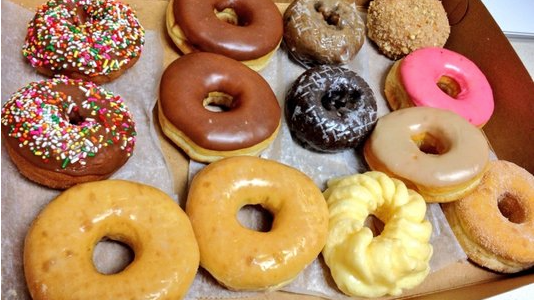Why Do Bakers Have Bigger Dozens?

A dozen, by definition, is twelve of something — eggs, doughnuts, roses, it doesn’t matter. And if you buy a dozen eggs or roses from a grocer or florist, you’re going to get exactly that — 12 of the item. But go to the baker and buy a dozen doughnuts, there’s a good chance you’ll get a bonus one. (You can see an example hanging out above — that vanilla-glazed one wedged in between four others in the bottom right.) “Baker’s dozens,” as they’re known, are groups of 13, and often, baked goods come in that increment.
But why do we get that extra free doughnut from the baker?
Most likely, you can credit medieval regulations for that little benefit.
Throughout history, there are plenty of examples of vendors cheating their customers. If you were a baker, that was rather easy — if you’re selling bread by the loaf, you can make a little extra dough (sorry!) by making loaves which are slightly smaller than your customer would otherwise expect. It’s doubtful that your customers would notice and even if they did, there wasn’t much recourse. But in 13th century England, the Crown stepped in. According to Mental Floss, “King Henry III was so irked by the problem that he implemented a new law to standardize the weight of a loaf—selling puny loaves could result in beatings or jail time.”
Bakers didn’t want to provoke the ire of the law, but as Encyclopedia Britannica points out, “even with careful planning it is difficult to ensure that all of your baked goods come out the same size; there may be fluctuations in rising and baking and air content, and many of these bakers didn’t even have scales to weigh their dough.” There was a chance that, on average, the loaves would be smaller than the regulations required. The solution: bake 13, not 12, and give that extra one away for free. When a customer bought the full dozen, he or she was all but guaranteed to get more than what they bargained for, and you, the baker, was protected from liability.
There are other theories out there explaining why we have baker’s dozens, and because the term dates back at least until the late 1500s, it’s unlikely we’ll ever know if the explanation above is definitive. It is, however, the most likely, given what we know about the history of baked goods.
Bonus fact: We have ten fingers — so why do eggs and breads and roses get sold in dozens, anyway? The whole story is also lost to antiquity, but again, the prevailing theory comes from England of the Middle Ages. Beginning in the mid-1500s, twelve English pence were worth one shilling; per the New York Times, selling items by the dozen allowed vendors to sell a solo egg (or whatever the product was) for a penny. The custom stuck despite a shift to a base-ten currency system.
From the Archives: Thirteen, fourteen, fifteen… see a pattern? Here’s what “eleven” and “twelve” aren’t “oneteen” and “twoteen.”
